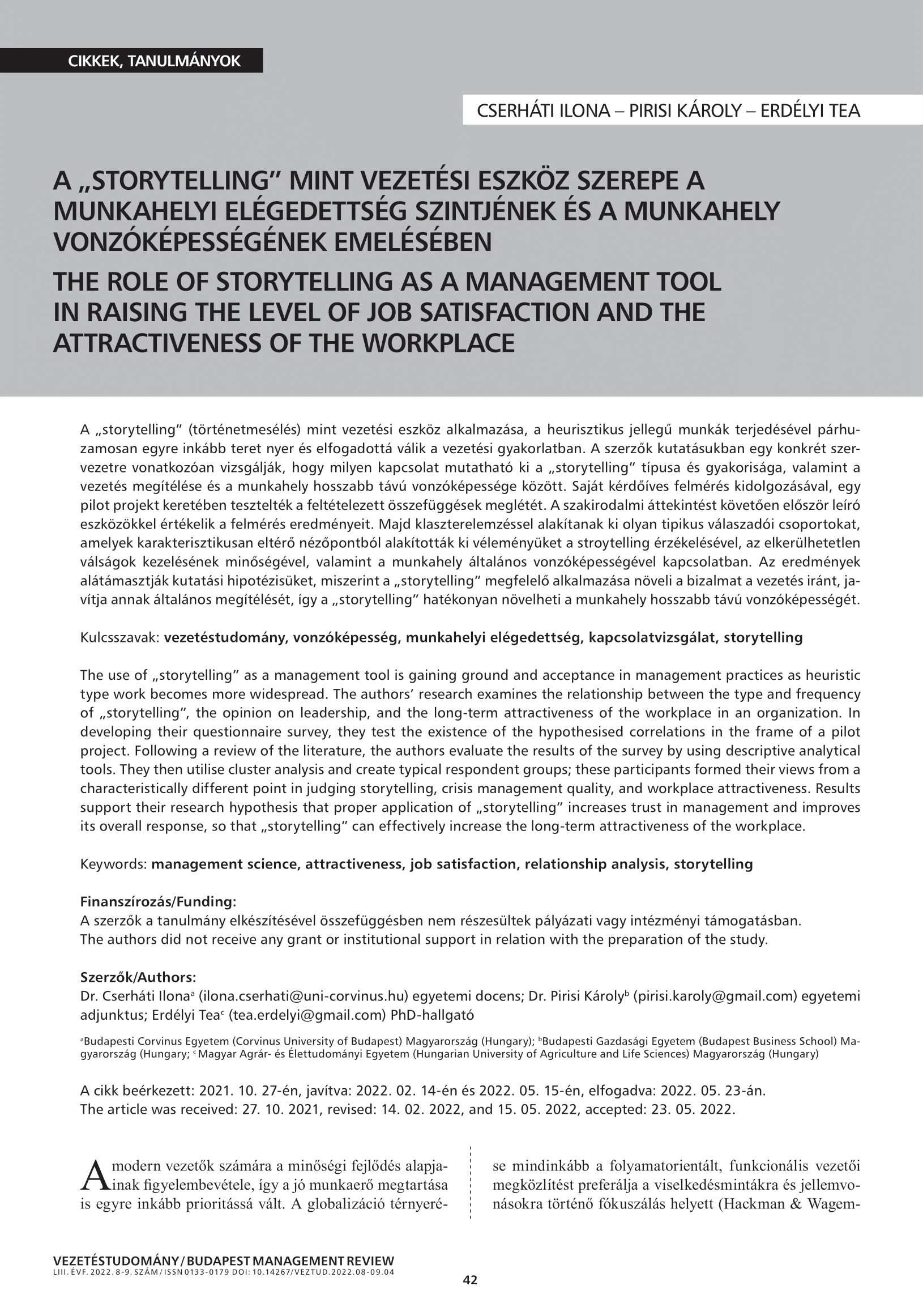A „storytelling” mint vezetési eszköz szerepe a munkahelyi elégedettség szintjének és a munkahely vonzóképességének emelésében
DOI:
https://doi.org/10.14267/VEZTUD.2022.08-09.04Keywords:
management science, attractiveness, job satisfaction, relationship analysis, storytellingAbstract
The use of „storytelling” as a management tool is gaining ground and acceptance in management practices as heuristic type work becomes more widespread. The authors’ research examines the relationship between the type and frequency of „storytelling”, the opinion on leadership, and the long-term attractiveness of the workplace in an organization. In developing their questionnaire survey, they test the existence of the hypothesised correlations in the frame of a pilot project. Following a review of the literature, the authors evaluate the results of the survey by using descriptive analytical tools. They then utilise cluster analysis and create typical respondent groups; these participants formed their views from a characteristically different point in judging storytelling, crisis management quality, and workplace attractiveness. Results support their research hypothesis that proper application of „storytelling” increases trust in management and improves its overall response, so that „storytelling” can effectively increase the long-term attractiveness of the workplace.
Downloads
References
Adamik, T. A., Jászó, A. & Aczél, P. (2004). Retorika. Budapest: Osiris.
Andrade, G. A. (2018). A storytelling tudománya – Hogyan adj el könnyen és eredményesen, ahogy az igazán sikeres vállalkozók? Budapest: Magánkiadás.
Boje, D. M. (2018). Organizational Research: Storytelling in Action. London: Routledge.
Bokor, A. (2000). Szervezeti kultúra és tudásintegráció: A termékfejlesztés problémája (PhD-értekezés). Budapest: Budapesti Közgazdaságtudományi és Államigazgatási Egyetem. http://phd.lib.uni-corvinus.hu/158/1/bokor_attila_hu.pdf
Brown, D. S. (2013). Interfaith dialogue: listening to communication theory. Living Within the Abrahamic Traditions. Lanham, Md.: Lexington Books.
Bruner, J. (2001). A gondolkodás két formája. In László, J. & Thomka, B. (Eds.), Narratívák 5. Narratív pszichológia (pp. 29-51). Budapest: Kijárat Kiadó.
Bryant, A. (2010). Team insight? Just use your peripheral vision. The New York Times, 14.08. https://www.nytimes.com/2010/08/15/business/15corner.html
Buda, M., & Péter-Szarka, S. (2015). A kreatív klíma: új irány az iskolai klíma és a konfliktuskezelés kutatásában. Iskolakultúra, 25(9), 3-17. https://doi.org/10.17543/ISKKULT.2015.9.3
Busselle, R., & Bilandzic, H. (2008). Fictionality and Perceived Realism in Experiencing Stories: A Model of Narrative Comprehension and Engagement. Communication Theory, 18(2), 255–280. https://doi.org/10.1111/j.1468-2885.2008.00322.x
Cherniss, C. & Roche, C. W. (2020). Érzéssel vezetni. Budapest: Pallas Athéné Könyvkiadó.
Denning, S. (2012). TEDx: Storytelling – The Secret Key to Leadership. Forbes, 12.01. https://www.forbes.com/sites/stevedenning/2012/01/12/tedx-storytelling-the-secret-key-to-leadership/#150c24d37f66
Fisher, W. R. (1984). Narration as a human communication paradigm: The case of public moral argument. Communication Monographs, 51(March), 1-22. https://doi.org/10.1080/03637758409390180
Gabriel, Y. (2000). Storytelling in Organizations: Facts, Fictions, and Fantasies. Oxford: Oxford University Press.
Gallo, C. (2016). Storytelling, A történetmesélés ereje. Budapest: HVG.
Goleman, D., Boyatzis, R., & McKee, A. (2002). Primal leadership: Realizing the power of emotional intelligence. Boston: Harvard Business School Press.
Griffin, E. M. (2001). Bevezetés a kommunikációelméletbe. Budapest: Harmat Kiadó.
Hackman, J. R., & Wageman, R. (2005). A theory of team coaching. Academy of Management Review, 30(2), 269-287. https://citeseerx.ist.psu.edu/viewdoc/download?doi=10.1.1.494.4814&rep=rep1&type=pdf
Hackman, J. R., & Wageman, R. (2007). Asking the right questions about leadership. American Psychologist, 62(1), 43-47. http://dx.doi.org/10.1037/0003-066X.62.1.43
Hall, K. (2021). A sztori, amire emlékezni fogsz. Budapest: 21. Század Kiadó.
Heidrich B. (2002). Szervezeti kultúra és interkulturális menedzsment. Budapest: Human Telex.
Herzberg, F. A. (1987). One more Time: How do you Motivate your Employees? Harvard Business Review, (Sept-Oct), 87507-87515. https://www.insidemarketing.it/wp-content/uploads/2020/08/one_more_time_-_how_do_you_motivate_employees.pdf
Huaiyang, C. (2019). Storytelling and employee engagement from the CCO perspective: A case study in a nonprofit organization (Master’s thesis). Lund, SE: Lund University. https://lup.lub.lu.se/luur/download?func=downloadFile&recordOId=8993432&-fileOId=8993444
Hunyadi, L., Vita, L. (2004). Statisztika közgazdászoknak. Budapest: KSH.
Ivanova-Gongne, M., & Törnroos, J-Å. (2017). Understanding cultural sensemaking of business interaction: A research model. Scandinavian Journal of Management, 33(2), 102-112. https://doi.org/10.1016/j.scaman.2017.04.001
Judge, T. A., Colbert, A. E., & Ilies, R. (2004). Intelligence and leadership: A quantitative review and test of theoretical propositions. Journal of Applied Psychology, 89(3), 542-552. https://doi.org/10.1037/0021-9010.89.3.542
Kleiner, A., & Roth, G. (1997). Learning Histories: A New Tool For Turning Organizational Experience Into Action. New 21th Century Working Papers Series 1997/9, MIT Center for Coordination Science. http://ccs.mit.edu/lh/21cwp002.html
Lankow, J., Ritchie, J., & Crooks, R. (2012). Infographics: The power of visual storytelling. Chichester, UK: John Wiley & Sons Press.
László, J. (1999). Társas tudás, elbeszélés, identitás – a társas tudás modern szociálpszichológiai elméletei. Budapest: Scientia Humana Kiadó.
Lövey I., Manohar, S. N., & Erdélyi, E. (2003). Az örömteli szervezet. Budapest: HVG Kiadó.
National Science Board (2020). Science & Engineering Indicators 2020. Alexandria, VA: NSB. https://www.nsf.gov/pubs/2020/nsb20201/nsb20201.pdf
Norris S. P., Guilbert S. M., Smith M. L., Hekimelahi S., & Phillips L. M. (2005). A Theoretical Framework for Narrative Explanation in Science. University of Alberta, Edmonton, Alberta T6G 2G5. https://doi.org/10.1002/sce.20063
Ryan, R. M., & Deci E. L. (2000). Self-determination Theory. New York: Guilford Publication.
Schein, E. H. (1985). Organizational culture and leaderschip: A dynamic view. San Francisco: Josey-Bass Publisher.
Scitovski, R., Sabo, K., Martínez-Álvarez, F., & Ungar, Š (2021). Cluster Analysis and Applications. Cham: Springer.
Simmons, A. (2006). The Story Factor: Inspiration, Influence, and Persuasion through the Art of Storytelling. New York: Basic Books.
Simon, H. A. (1982). Korlátozott racionalitás. Budapest: KJK.
Simon, J. (2006). A klaszterelemzés alkalmazási lehetôségei a marketingkutatásban. Statisztikai Szemle, 84(7), 627-650. https://www.ksh.hu/statszemle_archive/2006/2006_07/2006_07_627.pdf
Thier, K. (2018). Storytelling in Organizations: A Narrative Approach to Change, Brand, Project and Knowledge Management. Heidelberg: Springer-Verlag Berlin.
Török, J. (2013). Kultúrák a szervezeti történetek tükrében (PhD-értekezés). Pécs: Pécsi Tudományegyetem Bölcsészettudományi Kar, Nyelvtudományi Doktori Iskola. https://pea.lib.pte.hu/bitstream/handle/pea/15502/torok-judit-phd-2013.pdf?sequence=1&is-Allowed=y

Downloads
Published
How to Cite
Issue
Section
License
Copyright (c) 2022 Vezetéstudomány / Budapest Management Review

This work is licensed under a Creative Commons Attribution 4.0 International License.
Authors assign copyright to Vezetéstudomány / Budapest Management Review. Authors are responsible for permission to reproduce copyright material from other sources.

